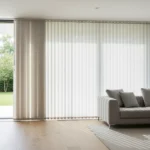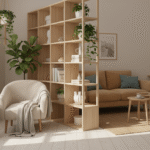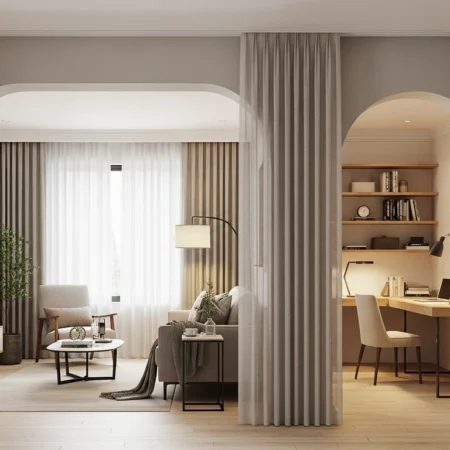Tiny studio apartments present unique design challenges, but thoughtful layouts can transform them into highly functional, multi-zoned sanctuaries. The key involves strategically defining distinct areas for living, sleeping, and working without sacrificing precious square footage or visual flow.
Clever zoning techniques allow residents to enjoy both privacy and a sense of spaciousness, making small footprints feel significantly larger and more organized. These innovative ideas focus on creating cozy, purposeful zones within even the most compact urban dwellings.
Slatted Wood Screens

Installing vertical slatted wood screens provides an excellent semi-private divider, allowing light and air to circulate freely throughout the studio apartment. These elegant architectural elements create a clear visual separation between zones like the bedroom and living area without completely blocking the view.
- Visual Transparency: Maintains an open, airy feel while subtly delineating specific functional areas within your compact space.
- Architectural Interest: Adds significant design appeal and a touch of natural warmth, elevating the aesthetic of any modern studio apartment.
- Light Permeability: Allows natural light to penetrate deeply into all corners, preventing any section from feeling dark or enclosed.
Beyond their aesthetic appeal, slatted screens can be customized with various wood tones and finishes to complement any interior design style. They effectively create a psychological boundary, fostering a sense of distinct rooms within a single open-plan area.
Floating Glass Partitions

Floating glass partitions offer a sophisticated and minimalist approach to defining zones, providing an unobstructed visual connection while physically separating distinct functions. These transparent dividers are perfect for maintaining an expansive feel in tiny studios, especially when delineating sleeping quarters from main living spaces.
- Maximized Light: Ensures that natural and artificial light can freely permeate all areas, making the entire studio feel brighter and more open.
- Modern Aesthetic: Contributes a sleek, contemporary look that enhances the overall design appeal of a compact urban dwelling.
- Sound Dampening: Offers a degree of acoustic separation, providing a quieter environment for sleeping or focused work without full enclosure.
Opting for frosted or reeded glass options can introduce an additional layer of privacy without sacrificing too much natural light transmission. These elegant partitions are ideal for creating a designated bedroom nook that still feels connected to the rest of the studio.
Low-Profile Bookshelves

Strategically placed low-profile bookshelves serve as functional room dividers, offering valuable storage while subtly defining distinct zones within a studio apartment. Placing a sturdy, open-back unit between a living area and a sleeping space creates a soft visual barrier without completely isolating either section.
- Dual Functionality: Provides essential storage for books and decorative items, simultaneously acting as an effective room divider.
- Visual Definition: Establishes clear boundaries for different activity zones, enhancing the organization and flow of your studio.
- Accessibility from Both Sides: Allows items to be accessed from either the living or sleeping area, maximizing convenience and utility.
Choosing a unit that is shorter than eye-level helps maintain an open sightline, preventing the studio from feeling cramped or overly partitioned. This practical solution leverages existing furniture to create purposeful, cozy areas.
Curtain Track Systems

Installing ceiling-mounted curtain track systems offers a flexible and soft way to create defined zones, allowing residents to easily open or close off areas as needed. Fabric curtains provide instant privacy for sleeping or dressing, transforming an open studio into a multi-functional space.
- Flexible Privacy: Easily drawn for immediate seclusion in the sleeping area or pulled back to open up the entire studio apartment.
- Soft Texture: Introduces a warm, inviting textile element that enhances the overall coziness and aesthetic appeal of the space.
- Sound Absorption: Helps to slightly dampen ambient noise, contributing to a more peaceful and tranquil environment within your home.
Selecting heavy, floor-to-ceiling curtains can create a dramatic and effective room division, while sheer fabrics offer a lighter, more ethereal separation. This adaptable solution provides both aesthetic appeal and practical functionality for dynamic living.
Multi-Functional Furniture

Incorporating multi-functional furniture pieces is paramount in tiny studios, as they maximize utility and inherently define zones through their adaptable design. A sofa that converts into a bed or an ottoman with hidden storage effectively delineates a living area from a potential sleeping space.
- Space Optimization: Reduces the need for multiple single-purpose items, freeing up valuable floor space for other activities.
- Zone Integration: Furniture like a folding dining table or a storage bench can serve as both seating and a subtle room divider.
- Seamless Transitions: Allows for quick and easy transformation of a single area to accommodate different daily functions, from lounging to dining.
Investing in modular pieces or items with integrated storage, such as a bed with drawers underneath, further enhances the functionality of each zone. This smart approach ensures every square inch serves multiple purposes, defining areas without physical barriers.
Raised Platform Beds

Constructing a raised platform bed immediately creates a distinct sleeping zone, elevating the bed and often incorporating valuable storage underneath. This ingenious solution visually separates the bedroom area from the main living space, adding architectural interest and practical utility.
- Defined Sleeping Area: Clearly delineates the bed as a separate “room,” enhancing the feeling of a distinct private sanctuary.
- Integrated Storage: Offers ample space for drawers, shelves, or even a pull-out desk beneath the platform, optimizing vertical dimensions.
- Visual Layering: Adds depth and dimension to the studio, making the space feel more thoughtfully designed and less like a single box.
A platform can be customized with built-in lighting or power outlets, further enhancing its functionality as a self-contained bedroom nook. This smart design elevates comfort and organization within the compact studio environment.
Area Rug Zoning

Utilizing area rugs is a simple yet highly effective method for visually defining different zones within an open-plan studio apartment. Placing a distinct rug under the living room furniture and another under the bed immediately designates separate functional areas.
- Visual Anchoring: Grounds furniture arrangements, making distinct zones feel more purposeful and less like scattered pieces.
- Texture and Warmth: Introduces soft textures and colors, enhancing the overall coziness and aesthetic appeal of each defined space.
- Acoustic Comfort: Helps to absorb sound, slightly reducing echoes and contributing to a quieter, more comfortable living environment.
Choosing rugs with varying patterns, textures, or colors can further emphasize the unique identity of each zone, even in a small footprint. This versatile technique requires no construction, offering an immediate and impactful design solution.
Strategic Lighting Schemes

Implementing strategic lighting schemes is crucial for creating defined zones and enhancing the mood in a tiny studio apartment. Combining ambient, task, and accent lighting allows you to illuminate specific areas, signaling different functions and activities.
- Task Lighting: Utilizes focused light, such as a desk lamp or reading light, to clearly designate a workspace or reading nook.
- Ambient Illumination: Provides overall background light for general activities, ensuring the entire studio feels welcoming and well-lit.
- Accent Lighting: Highlights architectural features or artwork, drawing attention to specific areas and adding depth to your design.
Dimmable lights and smart lighting systems offer ultimate control, allowing you to adjust the intensity and color temperature to suit various activities or moods. Thoughtful lighting effectively carves out distinct “rooms” without any physical barriers.
Foldable Room Dividers

Foldable room dividers provide an incredibly versatile and non-permanent solution for creating defined zones in a tiny studio apartment. These portable screens can be easily deployed for instant privacy or folded away when an open layout is desired.
- Instant Privacy: Quickly screens off the sleeping area or a temporary workspace, offering immediate seclusion as needed.
- Flexible Layouts: Allows for dynamic adjustment of your studio’s configuration, adapting to different daily routines or guest visits.
- Aesthetic Enhancement: Available in various materials like wood, fabric, or bamboo, adding decorative flair and texture to your space.
Look for lightweight options that are easy to move and store, ensuring they complement your existing decor. This adaptable solution offers both practicality and design flexibility for small living spaces.
Custom Built-In Millwork

Investing in custom built-in millwork offers the most integrated and seamless approach to creating defined zones in a tiny studio apartment. Floor-to-ceiling units can incorporate shelving, a desk, and even a Murphy bed, forming distinct areas while maximizing storage.
- Maximized Storage: Utilizes every available inch, providing bespoke storage solutions that fit perfectly into your studio’s unique dimensions.
- Integrated Design: Creates a cohesive and sophisticated look, making the entire space feel thoughtfully designed and highly functional.
- Structural Zoning: Acts as a solid, permanent divider, clearly delineating areas like a sleeping nook, a home office, or a compact kitchen.
A clever built-in unit can feature a half-wall that separates the bed from the living room, incorporating shelves on both sides for maximum utility. This tailored approach transforms a small studio into a highly organized and luxurious multi-zoned home.
Mirrored Panels

Incorporating mirrored panels into your studio layout can subtly define zones while simultaneously enhancing the perception of space and light. A large mirror or a series of mirrored tiles strategically placed can visually expand a wall or act as a soft, reflective divider.
- Visual Expansion: Creates an illusion of greater depth and width, making a compact studio apartment feel significantly larger.
- Light Amplification: Reflects natural and artificial light, brightening darker corners and enhancing the overall luminosity of the space.
- Subtle Delineation: A full-length mirror positioned to face a specific zone, like a dressing area, can subtly frame and define that space.
Consider mirrored closet doors or a freestanding mirrored screen to introduce both functionality and a sense of openness. This elegant design trick adds sophistication while cleverly segmenting your living areas.
Half-Walls with Integrated Shelving

Constructing half-walls with integrated shelving provides a robust yet visually open solution for defining zones within a studio apartment. These partial walls offer structural separation for areas like a sleeping nook or an entryway while providing accessible storage on both sides.
- Physical Boundary: Establishes a clear, semi-permanent division that physically separates distinct functional areas without full enclosure.
- Built-in Storage: Offers convenient shelves or cubbies for books, decor, or everyday essentials, maximizing vertical space efficiency.
- Maintained Openness: Preserves a sense of connection and light flow between zones, preventing the studio from feeling claustrophobic.
The top surface of a half-wall can double as a desk, a breakfast bar, or a display area, further enhancing its multi-functional appeal. This practical architectural element creates cozy, defined zones with added utility.
Embracing these creative layout ideas transforms a single studio room into a series of distinct, purposeful, and inviting zones. Thoughtful design allows residents to enjoy both privacy and functionality, making compact living truly comfortable and stylish. By strategically defining areas, even the smallest apartment can feel expansive, organized, and perfectly tailored to your lifestyle needs.










